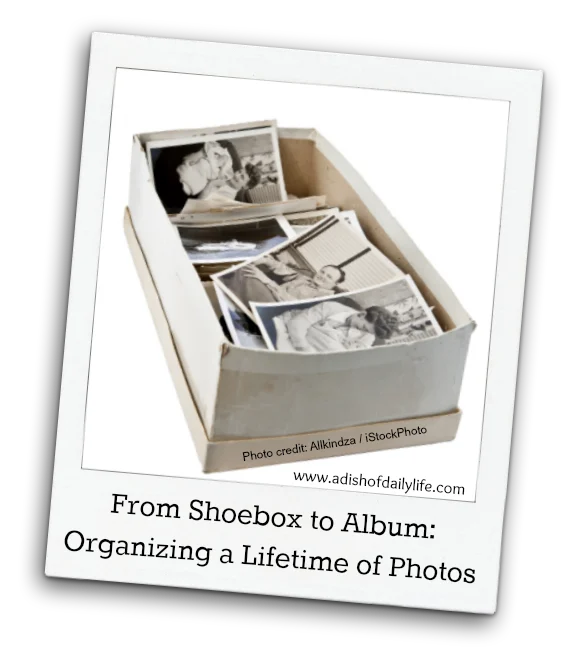Do you have boxes of photos tucked away in closets? Years of kids’ artwork? Did you inherit your parents photos?
Organizing a lifetime of photos can seem like a daunting task, but it doesn’t have to be.
Your photos and memorabilia are reminders of cherished memories and good times…they deserve a little TLC. Like any big organizing project, it may seem like a daunting task, but by breaking it down into steps, you’ll be able to organize a lifetime of photos (and memorabilia!) and find what you need quickly when you need it!

1. Gather everything in one place
That means photos, memorabilia, and old albums! Make sure you have a place where you can leave everything out. As with any big organizing project, the organization process isn’t going to happen overnight. Schedule a time to work on it every day, or at least every week. Organizing in bite size chunks will make the process easier.
2. Categorize
Do you want to organize chronologically, or are you willing to be a little flexible in your thought process?
It can be difficult to put unorganized photos into correct chronological order. When you’re talking 20, 30, 40 years worth of photos, it can be hard to pinpoint exactly when the photos were taken. Look for clues to help you such as the date developed on the envelope, the developing date stamp on the back of the picture, and the date stamp on the front of the picture. If you have old appointment calendars, you may be able to match up events with your photos. Asking other people who are in the picture may also prove to be helpful, as well as looking for trends such as clothing and hairstyles.
I actually recommend organizing with themes, and here’s why. When you have a lifetime of photos and memorabilia, you will find as you start the organizing process that there are underlying themes…certain events or activities that stand out the most. Perhaps you did a lot of traveling, or your family vacationed at the same spot for a number of years. Maybe your family was really into sports, or another special activity. Theme categories might include vacations, holidays, birthdays, hobbies, sports, or school years. Organizing by theme allows you to focus on the important stories, and should you decide to create albums with your photos, it will also help you decide what type of album(s) you want to make to tell your stories.
Album options include the family yearbook, special events, recurring events, and tribute albums, or even an album about a specific activity.
- The family yearbook is a great way to include everyday moments as well as milestone events. When you have years worth of photos, you’ll want to prioritize which events you want to highlight. The rest of the photos you’d like to keep can go into your photo storage box.
- A special event album can highlight an event that is truly important to you, such as a family reunion or a special family vacation.
- An album of recurring events might highlight the vacations you took over the years, family parties, or even pictures of Christmas every year.
- A tribute album can take the form of celebrating a life, or it can even celebrate a certain time in life, such as military service or graduation, or even a milestone birthday filled with letters from family and friends.
- An activity album would include pictures and stories about a specific activity or hobby. An album of your child’s artwork would fall into this category.
3. Decisions, decisions…What to save and what to keep
Think of your photos and memorabilia in terms of the ABCs.
Your A photos are the ones that you’d like to keep in an album where you can tell the stories (S) behind the pictures.
Your B photos are ones that you’d like to save for one reason or another, but they don’t necessarily have an active role in the stories you want to tell. You can store these in an photo safe storage box.
C stands for the can, as in garbage can. These are the photos you should give yourself permission to throw away. Most of us have amassed quite a collection of photos…but we really don’t need them all. Toss the bad ones, the blurry and the dark photos, the ones with the heads cut off. For the most part, you can probably get rid of the landscape photos as well. You’ll want to save a few of these if they are important to your story. Bear in mind there may be a not-so-great picture or two that you do want to save, because it has significance to a story you want to preserve.
4. Safe storage
Now that you’ve got them organized, you are going to want to make sure you store them safely. Your photos like to live in the same sort of environment as you. Basements, attics and garages are not good places to store your photos due to humidity, dampness and temperature swings. Actually, an interior above ground closet is the best place to store your photos because of it has a constant temperature year round.
Using archival storage materials is also important. Choose an archival photo storage box that is acid and lignin free. If you are using a plastic container, look for uncoated pure polyethylene, polypropylene, or polyester (also known as Mylar D or Mellinex 516). These are considered stable and non damaging to photos.
5. Scan and Share
In addition to being a backup for your printed photos, scanning opens up lots of possibilities of what you can do with your pictures. All those photos you inherited from your parents? Once they are scanned, you can share them with the rest of the family! This can be done professionally, or if you prefer to just scan certain photos, consider purchasing a Flip Pal.
This is a small lightweight portable scanner that allows you to scan photos in albums and through glass (if you have a photo that is stuck to the glass, this may be the best alternative). You can even scan larger items and Flip-Pal’s software will stitch the photo together for you!
Once digitized, the sky’s the limit…you’ll have a lot more options for your photos, such as slide shows, photo gifts, and digital photo books. All of these can be created in multiples, so more of your family can enjoy family stories and memories!
Your photos and stories are unique and special! If you find organizing your photos overwhelming, consider working with a photo organizer in your area. But don’t put the organizing process off…there’s no time like the present to preserve your memories!


ljsreveries
Saturday 23rd of January 2016
I like the idea that I don't have to put them all in an album - only the ones that tell the story the best. That's a great tip. And not doing albums chronologically saves a lot of time.
purpleslobinrecovery
Wednesday 20th of January 2016
Haha, I came here from today's TUT, and lo and behold, I already commented back in Sept! ;)
purpledani9
Friday 11th of September 2015
I love these ideas and you make it seem actually doable! Just wanted you to know that you're being featured at the WEEKEND WIND DOWN LINK PARTY tonight at 6pm EST! Hope to see you there again! Thanks for linking up with us! Have a wonderful day!
Michelle Nahom
Friday 11th of September 2015
Thanks so much! It actually is really do-able! Actually just this week I had someone contact me and say they are starting the process and finding they CAN throw things away! :)
Linda
Wednesday 9th of September 2015
You are featured on my Facebook page today. Best wishes, Linda @Crafts a la mode
Michelle Nahom
Wednesday 9th of September 2015
Headed over now!
Linda
Wednesday 9th of September 2015
PINNED. Great tips for organizing all the photos. Your friend, Linda @Crafts a la mode
Michelle Nahom
Wednesday 9th of September 2015
Thank you, Linda!